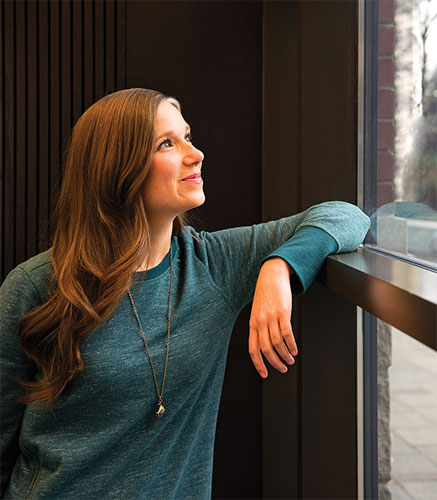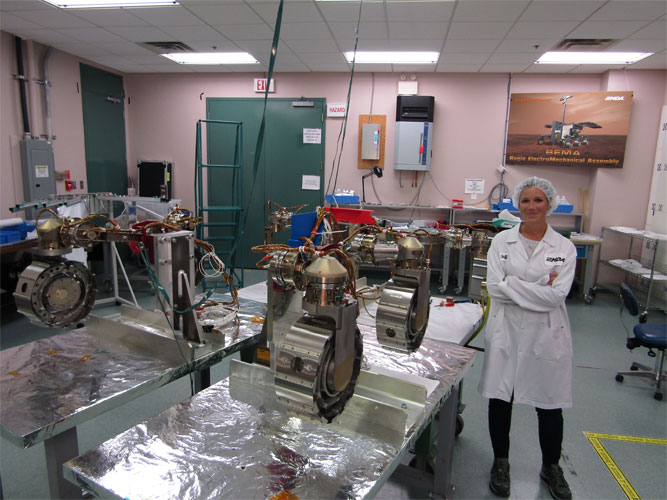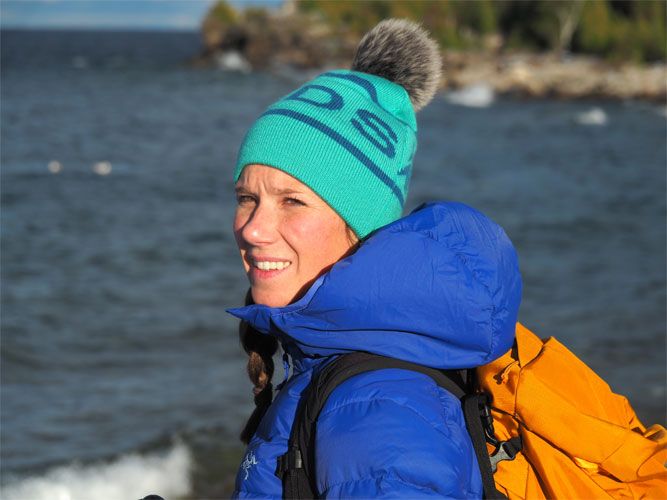Nearly every morning when I woke up for Junior High School, I ran to our front door to pick up our local newspaper, the Calgary Herald, from the front steps. Sometimes the paper was wet from rain, other times warm from sitting in the sun, and often ice cold and covered in a layer of frost. Either way it came, I brought the paper to our kitchen table and flipped through each section until I came to Science and Technology. I was looking specifically for stories about space exploration. When I saw an article covering Canada in space, I neatly cut out the pages and organized each into protective covers to store in a binder. As a young girl dreaming of the stars, with big goals to work in the space industry, this was my way of capturing history. My way of capturing what the accomplishments of Canadian engineers, scientists, and astronauts meant to me. Through these articles I felt connected to their stories; where what seemed impossible became truly possible.

Natalie Panek
Natalie Panek is an aerospace engineer at MDA, a Maxar Technologies company, as well as an avid adventurer. She works on Canadian space robotics and space exploration programs, including the chassis and locomotion systems for ESA’s ExoMars 2020 Mars rover. Natalie is also a member of the Explorer’s Club and a Fellow of the Royal Canadian Geographic Society.
Image credit: Sian Richards
Twenty years later I can probably say that I have made it in Canada’s aerospace industry. I am an Engineer in Mission Systems at MDA and have for nearly the last decade worked on a variety of Canadian space initiatives. Everything from the development of robotic systems to repair satellites in orbit that are no longer working (think robotic arms like the Canadarm and robotics tools), studying how hazardous lunar dust affects hardware that we would use for a lunar habitat or rover, and even helping to design the chassis and locomotion system for ESA’s ExoMars rover, scheduled to launch in 2020 (the chassis and locomotion system is how the rover drives around on Mars i.e. its legs, wheels, motors etc.).

Natalie standing next to a prototype of a drive system for ESA’s ExoMars 2020 Mars rover. Image credit: MDA
Super cool, right!? Unfortunately, the majority of Canadians are not aware of the innovative and one-of-a-kind projects that Canadian aerospace companies are building right here at home. A recent poll conducted by Ipsos Public Affairs indicated that the “knowledge of Canada’s history, accomplishments and current areas of leadership in space is low”. This is not really surprising – we need to do a better job communicating our work. The good news is that the majority of Canadians are proud of our accomplishments in space and feel that the space sector contributes to the Canadian economy. This is a positive sign for establishing a long-term strategy for Canada’s role in space. So why does space matter?
Space touches every aspect of our lives, whether we realize it or not. Light-Emitting Diodes (LEDs), anti-icing systems, gear for firefighters, foam, water purification, and even efficient solar cells are just a few of the technologies that are a direct result of space research. Our legacy Canadarm technology that flew on the Space Shuttle, or Canadarm2 operating on the International Space Station, have been adapted to help surgeons perform brain surgery or to help inspect nuclear reactors. GPS, weather monitoring, agricultural monitoring, and search and rescue for example, all rely on satellites orbiting the Earth. Everything from how we travel around, to what we eat, to how we communicate on a day-to-day basis are enabled by space technology. These spin off technologies are perhaps the more obvious reasons why we need steady investment in space science and engineering. But perhaps a subtler motivator is simply to learn, whether sending rovers to another planet, launching spacecraft into deep space, or crewed missions to Space Station or beyond.
Learning in the space industry – from talented colleagues, from failure, from challenging projects – is something I have had an opportunity to do a lot of in my career. I participated in a Space Studies Program through the International Space University, held at NASA’s Ames Research Center after completing my master’s degree in Aerospace Engineering. I was part of a large Canadian contingent that immersed ourselves in all things space. Lectures and panels with prominent individuals in the space community, tours of aerospace companies, courses in spacecraft design, space policy and law, space physical and life sciences, and more. Despite all the focus this program placed on space specifics, it most importantly taught us how to view space from different perspectives. To look at exploration from a wider lens and consider what comes next for the space industry in Canada. To consider our long-term goals and how to engage young people to work on things we know are hard, in order to solve some of the most pressing problems of our time. And to consider how can we meet those long-term goals while also living sustainably on our own planet.

Through decades of Canadian space technology development (Canada’s first satellite, Alouette 1, was launched in 1962 to study the ionosphere) we have led by example to create a collaborative and inclusive environment for space exploration. We understand that our collective knowledge across nations is powerful, where exploring together allows us to set those seemingly impossible goals and make them possible. To dream bigger. As we explore, what we learn connects us with each other, and what we learn connects us with Earth. This is pivotal because space exploration allows us to find ways to meet the needs of the present without compromising the ability of future generations to meet their own needs. Space science, engineering, and research matter because the more we look out there – the more we explore beyond what we know and beyond our own biases – the more we learn about ourselves.


